If you’re looking for a great way to connect with your customers and build lasting, meaningful relationships, look no further. A newsletter is an excellent way to distribute fun, engaging content to your audience. With some planning, it can be a great long-term tool for your retention strategy. Here’s how to create a newsletter for your business.
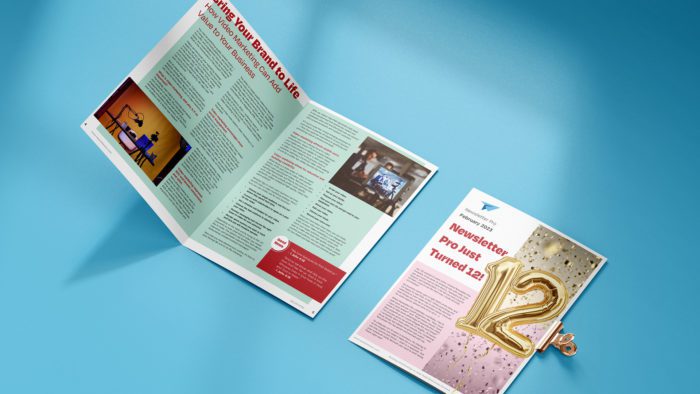
Who Are We?
Before we get into the details of how to create a newsletter for your business, it’s worthwhile to cover our credentials first. At Newsletter Pro, we’re experts in writing, designing, editing, printing, and distributing excellent newsletter content.
For over a decade, our goal has been to help business owners across the country form lasting, meaningful relationships with their audiences through content. We have helped thousands of entrepreneurs achieve higher retention, referral, and reactivation rates through the power of content.
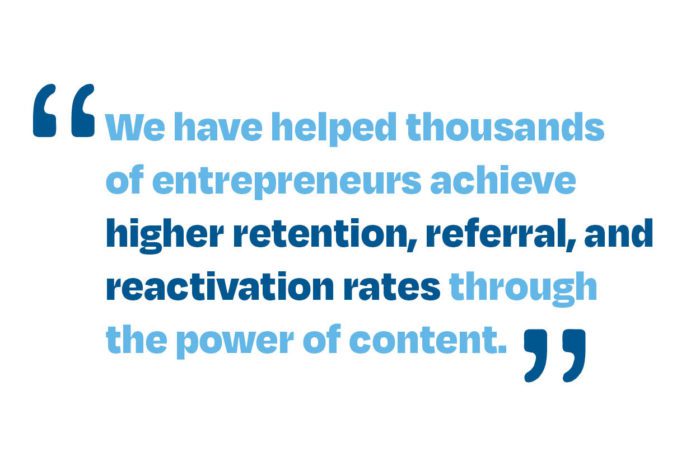
And now, we’re passing that privileged information on to you so you can get the same great results from your business newsletter.
So, without further ado, here’s how to create a newsletter for your business (from the Pros).
Determine Your Purpose.
Before you think about starting a newsletter (or any new marketing strategy, for that matter), you must reflect on your purpose.
- Why are you interested in implementing a newsletter?
- What are you hoping to accomplish with your newsletter?
- Who are you trying to reach with your newsletter?
- How will a newsletter support your business goals?
While your purpose might vary slightly depending on your industry, you’ll want to follow a few fundamental guidelines.
- Newsletters are not for selling. If you’re trying to sell to your clients, send them a flyer. A newsletter should be used to build relationships with your customers.
- Your content should add value. If your content is dull, overly specific, or unrelatable, your clients will not read it. Instead, your newsletter should contain exciting content tailored to your audience’s tastes.
- Quarterly won’t cut it. To get the most out of your newsletter campaigns, you need to be more consistent. That means sending out your newsletter at least once a month.
Once you have outlined your purpose and goals for your newsletter, it’s time to start planning your strategy.
Plan Your Strategy.
You will want to focus on the technical details of your newsletter production process. Here are just a few essential questions you should answer before committing to a newsletter.
- What methods will you use for distribution?
- Who do you want to be on your list?
- How are you going to segment your list?
- Who will write and edit your content?
- Who will design your newsletter layout?
- How are you going to track engagement?
- What topics do you want to cover in your content?
- Are you planning to have consistent, recurring sections in your newsletter? If so, on what topics?
- How far in advance are you planning to create your newsletters?
- Who will be in charge of reviewing and approving content?
Once you have these questions answered, it’s time to create a timeline. It should include detailed information on who will be doing what tasks, when, and what each stage in the process will look like. Here’s an example of a thorough timeline.
- Andrea will begin topic planning and research for the March newsletter 2 months in advance on Jan. 2. She will complete this task by Jan. 4.
- Ben will review and approve content topics by Jan. 5, then assign content to the writing team.
- Carlos and Debbie will write the assigned article content between Jan. 6 and Jan. 10.
- Evan and Felicity will review and edit the content by Jan. 13, then submit it for approval.
- Gregory will review and approve the content by Jan. 15.
- Helga will format and design the newsletter using the content she received by Jan. 18.
- Igor will approve the newsletter design by Jan. 20.
- The newsletter will be sent to the printing team, where Jessica will oversee the printing and distribution of the newsletter. The final newsletter will be mailed out on the last day of February.
Your timeline may look different depending on your preferences, the average workload of your employees, and how long you anticipate your newsletter to be.
Once your timeline is complete, make sure it is accessible to the whole team and that you communicate the due dates clearly. Putting time buffers between tasks may also be worthwhile in case something goes wrong during the process.
Get Your List Together.
You shouldn’t even be asking how to create a newsletter for your business before you have your list together. Without a properly maintained and organized list, you won’t have the resources necessary to deliver your content to your audience.
Here are some key things to keep in mind when compiling your list.
- Who do you want to be on your list?
- How do you plan to collect their data?
- What data do you intend to collect?
- Where do you plan to store the data?
Once you answer those questions, gathering data is the first step to creating your list. What works for your business will vary greatly depending on your industry. Some companies will ask for face-to-face information, while others may collect information through other means, like online surveys. Some may even offer incentives for customers who join their list.
After you have your list data, you must have a suitable place to store it. While an Excel spreadsheet could work in theory, it is often complicated to keep updated and lacks the automation tools necessary to manage your list easily. If you’re going to invest a great deal of time and energy into newsletter marketing, then it’s a good idea to invest in some list management software to organize your data.
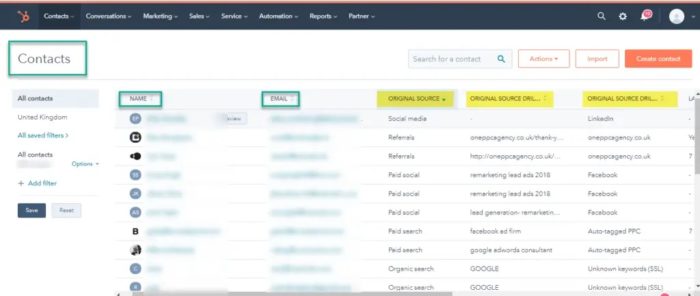
Segmenting your list into relevant groups will also be vital to personalize your content effectively. Then, you can send appropriate offerings to different audience members based on their interests, demographics, sales funnel stage, and more.
Lastly, your list should never become stagnant. Consistently add new people to your list and purge outdated entries. It’s recommended that you update your list at least once a month.
When executed correctly, a well-managed list can become an invaluable tool for ensuring your newsletter has the best chance of success.
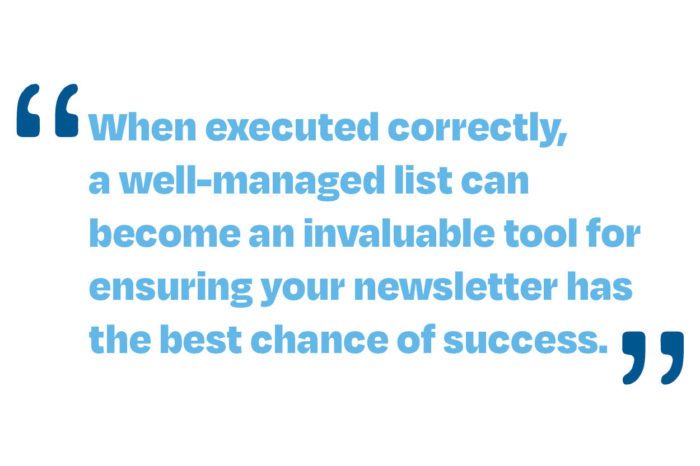
Plan Your Content.
If you want to know how to create a newsletter for your business and see great results, then you can’t underestimate the importance of content planning.
In many cases, content planning can be more critical than content writing because it lays the groundwork for the topics you will cover. If you select dull topics during the planning stage, even the best writers will struggle to spin them into exciting stories during the content creation stage.
But how do you know which topics you should cover in your newsletter?
Topic ‘Dont’s’
First, reviewing content topics you shouldn’t cover is essential. Here are just of few of the universal themes to stay away from.
- Anything trashy, illegal, or disturbing
- Think “10 Embarrassing Pictures Of Celebrities Postpartum,” “8 Signs That You Have an Infection (With Pictures),” or “22 Great Places To Hide A Body.”
- Overly specific topics, niche, or technical content
- Think “The Semantics Of 18th Century Gothic Poetry” or “How To Build A Hyper-Hydraulic Flux Capacitor.”
- Overly personal or embarrassing content
- Think “8 Dumb Things My Stupid Wife Did” or “6 Embarrassing Pictures I Took Of My Clients Without Consent.”
- Privileged information
- Think “Mrs. McMillian’s Secret Dental-Chair Confession” or “Secrets My Law Clients Told Me In Confidence.”
- Controversial or sensitive subjects
- Think “Why I Think The Current President Is Terrible” or “My Thoughts On The Latest National Tragedy.”
While many of those topics might seem obvious, they are more common than you think when businesses write their newsletters.
We have seen dental clients write countless disturbing articles about cavity progression and include matching pictures in their newsletters. We have seen clients attempt highly technical pieces in their newsletters about how to build complicated machinery. We have even seen dry-cleaning businesses fill their newsletters with boring articles about treating stains and fixing fraying hems.
To be clear, some of these topics might be valuable when used in the proper context and in good taste. However, a newsletter is not a suitable medium for that type of content. A newsletter should be centered around content that broadly appeals to your audience, even if it’s not specific to your business.
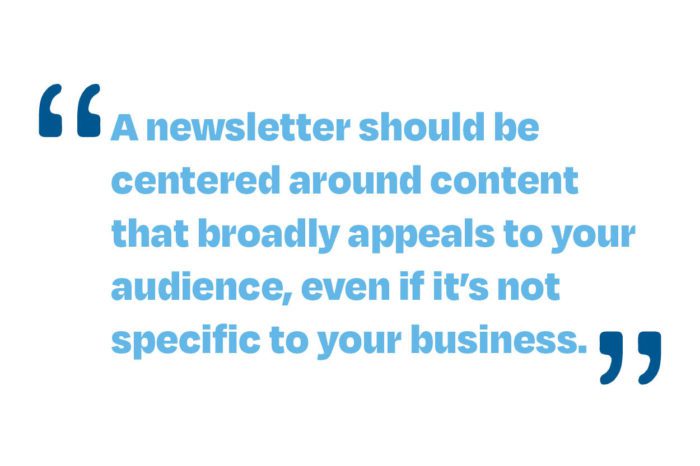
Topic ‘Do’s’
Specific subjects can be used successfully, no matter the context. Here are some great topics that will work for any newsletter, no matter the industry.
- Appropriate personal stories
- Think “Meet Mittens, Our New Kitten,” “Our Favorite Family Hanukkah Traditions,” or “Grandma Murphy’s 80th Birthday Party.”
- Recipes
- Think “Aunt Martha’s Peach Cobbler” or “Homemade Cosmic Brownies.”
- Puzzles
- Think crosswords, word searches, and sudoku.
This type of content has broad appeal and can also be used to form deeper connections with your audience because it’s personalized. Tailor your other content articles around your audience’s tastes.
For example, a private piano tutor might get great feedback about including sheet music of current pop songs on the back page of her newsletter. However, that content will likely not resonate with the audience of an auto mechanic’s newsletter. That’s why it’s essential to get feedback from your potential readers on what topics they enjoy and which ones they would like to see covered in the future.
Create Your Content.
Once your content plan is laid out and approved, it’s time to write.
As previously discussed, select someone (or multiple people) on your team to write content once it’s planned. Sometimes, this can be tricky if you don’t have an in-house marketing person or anyone with writing experience.
However, if you are willing to invest in tools like Grammarly and some proper writing training for your team, you might still be able to produce quality articles.
If you do not have anyone who can write on your team, consider paying a writer through a freelancing website.

Review Your Content.
After your content has been entirely written, edited, and designed, it’s time to review it.
The best way to do this is by asking multiple people with different perspectives for feedback on the finished product. Then, you can make any necessary tweaks or adjustments based on that feedback.
Once your content is thoroughly reviewed and approved by management, it can be moved forward to distribution.
Distribute Your Content.
Once your newsletter is ready, it’s time to go through the proper distribution channels to deliver it. Your delivery strategy will depend heavily on the distribution method you hope to use, your list size, and your newsletter size.
Distribution should be simple if you did your due diligence in the planning stage. If you’re sending email newsletters, you should have set up your email client during that stage and uploaded your current list. You can simply set the parameters for your newsletter and send it out to your audience.
It will be a bit more complicated for print, but it should still be straightforward with proper planning. In that case, you should have already contacted a printing company and given them your updated list. If you have these lined up, give them your completed newsletter in whatever form they request. Once it’s printed and labeled with the correct addresses, stamp and mail it in time to get it to your audience on schedule.
If that seems a bit overwhelming, it can be, which leads us to our next point.
Seek Expert Advice.
Are you still unclear on how to get started, need expert advice, or want advice on outsourcing your newsletter? In that case, you can always reach out to the experts. One of our Pros would be happy to schedule a no-pressure, complimentary strategy session to discuss your options and best practices. You can click here to sign up today.
We hope this guide was helpful to you wherever you are in your marketing journey. Remember, learning how to create a newsletter for your business is an ongoing process and will likely involve a lot of trial and error. However, with the right tools and careful planning, you can start experiencing the benefits of a newsletter for your business.
Want to learn more about the basics of newsletters and our history as a company? Fill out the form below to request your free copy of our founder’s book, “The Ultimate Guide to Newsletters.”






